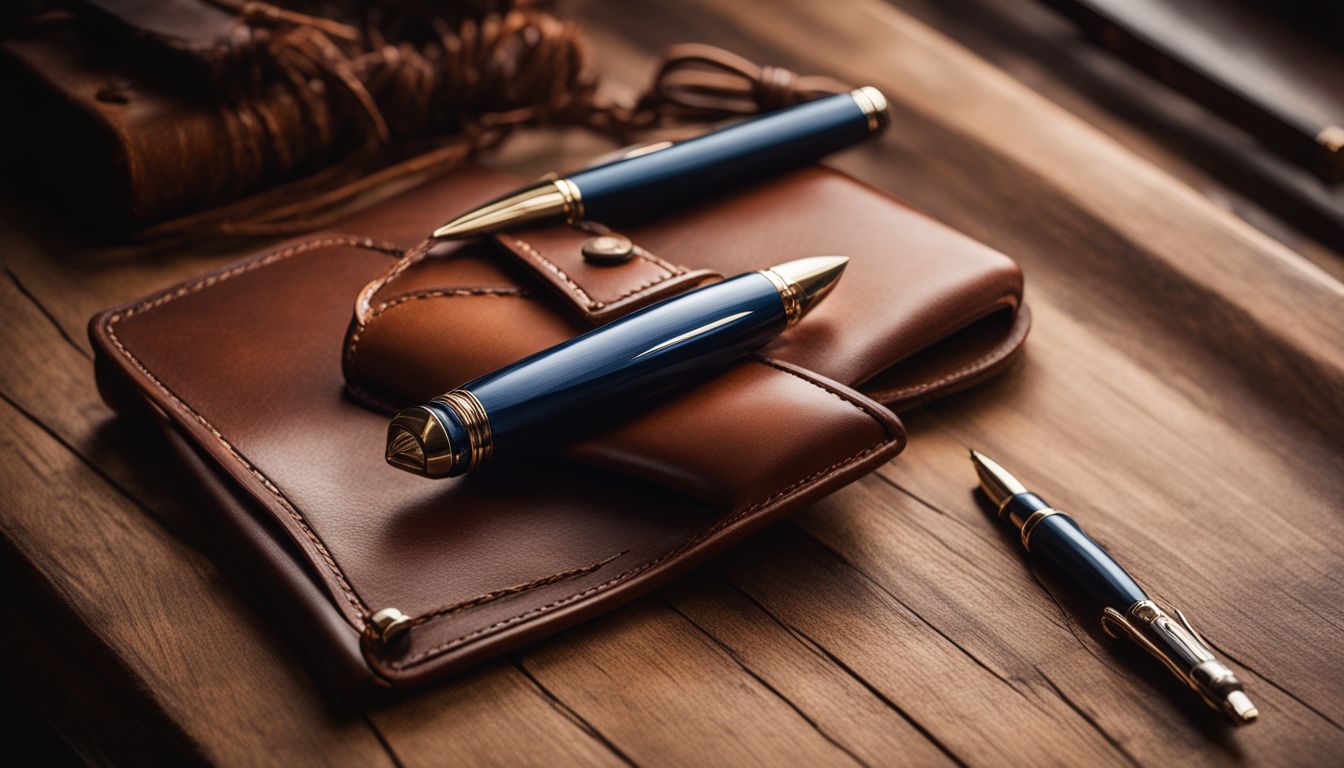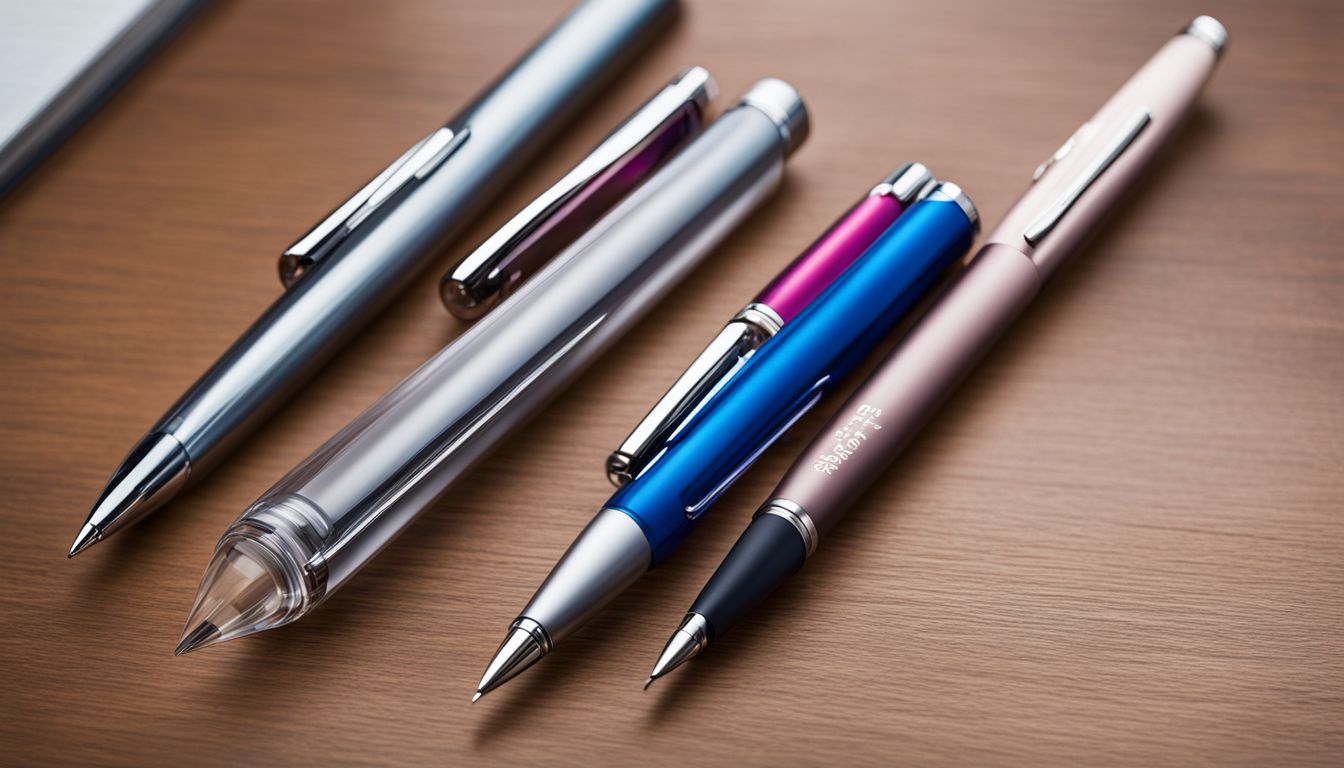Ever been in the middle of a crucial note or signing an important document when, out of nowhere, that trusty ballpoint pen decides to bail on you? Talk about a minor crisis. I get it; it’s incredibly annoying when your go-to writing instrument flakes just as you’re getting down to business.
But don’t worry, because I’ve rolled up my sleeves and dived headfirst into the nitty-gritty details of these everyday saviors to help ensure your next “pen-dicament” is nothing but smooth sailing.
In this piece, we’re going deep into the world of ballpoints—exploring their history, understanding different types, and offering some savvy troubleshooting tips. So let’s gear up and say goodbye to scratchy interruptions once and for all! Get ready for some serious ink action—it’s time we make those scribbles as smooth as silk!
Key Takeaways
- The first U.S. patent for a ballpoint pen was granted to John J. Loud in 1888, but the first successful commercial ballpoint pen, “The Rocket,” went on sale in New York City in 1945.
- Ballpoint pens come in two types: disposable ones that are thrown away after use and refillable ones that can be reloaded with new ink cartridges, which saves money and reduces waste.
- Ballpoints use oil – based ink delivered by a small metal or ceramic ball at the tip, making them less likely to leak than fountain pens.
- To keep a ballpoint pen working well, store it upright, clean it with a damp cloth, and replace refills when needed to prevent leaks and preserve ink quality.
- If there’s trouble with your pen like skipping or not writing, you might need to scribble on scrap paper or replace the refill; if it’s leaking or feels scratchy, check how it’s assembled and adjust your writing pressure.
The History of the Ballpoint Pen

Moving from the basics, let’s dive into how ballpoint pens began. A leather maker named John J. Loud got the first U.S. Patent for a ballpoint pen in 1888. His invention aimed to write on rough surfaces like wood and leather that fountain pens couldn’t handle.
Despite this breakthrough, it took many more years before someone improved upon his design.
In 1945, New York City witnessed the sale of “The Rocket,” which was the first modern ballpoint pen to hit the stores commercially. Unlike fountain pens known for their ink blots and leaks, “The Rocket” offered a cleaner writing experience with its innovative metal ball concept at its tip.
This marked a significant turn in writing instruments as people started embracing these reliable alternatives to quills and fountain pens.
Types of Ballpoint Pens

There are two main types of ballpoint pens: the Ballpointius Disposius, which is a disposable pen that comes with pre-filled ink cartridges, and the Ballpointius Refillius, which can be reloaded with new ink when it runs out.
Each type has its own unique features and benefits that cater to different preferences and needs.
Ballpointius Disposius
Let me tell you about the Ballpointius Disposius, better known as the disposable ballpoint pen. These pens are everywhere! You find them at banks, hotels, and schools. They’re light, super affordable, and you don’t need to worry about refilling them with ink.
Once they run out of ink, you just grab a new one.
Disposable ballpoint pens make writing smooth and easy. Their tips roll across paper without any skips or smudges. If I’m jotting down notes quickly or signing a receipt, I always reach for one of these trusty tools.
Plus, their low cost means losing one isn’t a big deal – there’s likely a dozen more in my drawer!
Ballpointius Refillius
Moving from the world of throwaway pens, let’s talk about Ballpointius Refillius—my go-to for a reliable writing tool. These refillable pens are not just better for the planet; they also come with higher quality ink.
I love that there’s a whole rainbow of colors to choose from and various shapes to fit any hand comfortably. The prices vary, so you can find one that won’t break the bank.
What makes these pens truly stand out is their eco-friendliness. By using them over time, you cut down on waste compared to tossing pen after pen away. Plus, being able to switch in new refills saves money in the long run—it’s a win-win! Customizing your writing is easy too; just pop in different types of refills and watch how it transforms your letters or notes.
Whether you’re jotting down quick reminders or drafting up something special, Ballpointius Refillius helps make it personal—and sustainable!
Physiology of a Ballpoint Pen
The physiology of a ballpoint pen varies – some have caps, while others click or twist open. Cartridges or refills play a vital role in ink dispensing, using a ball at the tip, typically made of metal or ceramic.
The ball rotates as it moves across the paper, allowing ink to flow steadily onto the surface.
Ballpoints disperse oil-based ink when pressure is applied. The viscosity and adhesive properties are crucial for the smooth flow of ink from the reservoir to the page. This mechanism ensures that only one small drop of ink adheres to the ball at any given time, preventing leaks and smudges while writing with this practical and versatile instrument.
Comparing Ballpoint and Fountain Pens
Let me break down the key differences between ballpoint and fountain pens for you. It’s a classic matchup: the trusty ballpoint versus the elegant fountain pen. Each has its own loyal fan base and for good reason. I’ve laid it all out in a clear-cut table so you can see exactly what sets these writing staples apart. Here’s what you need to know:
| Feature | Ballpoint Pen | Fountain Pen |
|---|---|---|
| Writing Comfort | Requires more pressure, can cause fatigue over long periods | Less pressure needed, smooth flow, comfortable for longer writing sessions |
| Ink Quality | Oil-based ink, dries quickly, less likely to smudge | Water-based ink, can take longer to dry, potential for smudging |
| Maintenance | Low maintenance, disposable options available | Higher maintenance, requires regular cleaning |
| Cost | Generally inexpensive, accessible to most budgets | Can be costly, especially for higher-end models |
| Refill Options | Replaceable cartridges or disposable | Refillable via ink bottles or cartridges |
| Environmental Impact | Disposable pens contribute to plastic waste | Reusable design, less waste over time |
| Writing Experience | Consistent line quality, less variance in writing style | Varied line quality, allows for expressive writing |
| Accessibility | Widely available, easy to find in most stores | More niche, specialty shops may carry them |
Ballpoint pens make everyday writing a breeze with their no-nonsense approach. On the flip side, fountain pens offer a touch of class and a buttery-smooth writing experience. Deciding between the two often boils down to personal preference, the task at hand, and how much you value the art of writing.
Maintenance and Care of Ballpoint Pens
I keep my ballpoint pens in good condition by following these steps:
- Holding the pen upright to prevent ink leakage.
- Cleaning the pen with a damp cloth to remove any dirt or residue buildup.
- Storing the pens in a cool, dry place to maintain ink quality.
- Checking and replacing the refill when it runs out to avoid interruptions while writing.
- Avoiding excessive pressure when writing to prevent damaging the pen tip.
- Using compatible refills for optimal performance and longevity.
Troubleshooting Common Ballpoint Pen Issues
- Troubleshooting Common Ballpoint Pen Issues
- If your pen is not writing, try scribbling on scrap paper to get the ink flowing.
- When the ink skips or appears faint, check if the refill needs replacing or if the ball is clogged with debris.
- If the pen leaks, make sure the refill is properly inserted and the pen is stored upright when not in use to prevent leaking.
- Should you encounter scratchy writing, consider changing to a smoother refill or adjusting the pressure applied while writing.
- When experiencing inconsistent ink flow, clean the pen’s tip and refill to remove any obstructions.
- In cases of broken or stuck mechanisms, gently disassemble and reassemble the pen to realign components.
- For retractable pens that won’t retract, ensure that there’s no visible damage and try lubricating the mechanism with a small amount of silicone grease.
The Art and Techniques of Writing with Ballpoint Pens
Let’s dive into the art and techniques of using ballpoint pens. Mastering line variation is key to creating expressive strokes.. Experiment with varying pressure on the pen to achieve different line widths, adding depth and dimension to your writing or artwork.
Try crosshatching for shading by layering lines at different angles – this technique can bring a unique texture to your work.
Don’t forget about precision! Ballpoint pens are excellent tools for intricate details due to their fine tips. Embrace the build-up of layers: ballpoint ink dries quickly, allowing you to overlay colors and create rich, vibrant hues without smudging.
Let your creativity flow through these versatile writing instruments.
Conclusion
In conclusion, we explored the fascinating history of ballpoint pens, from their invention as a solution to fountain pen issues to the modern variations available today. We delved into the two main types: disposable and refillable, understanding their differences in material and quality.
Understanding the physiology of ballpoint pens equipped us with insights into their mechanisms for ink dispensing. Finally, we discussed maintenance tips and techniques for troubleshooting common issues, empowering us with practical knowledge for caring for these everyday writing tools.
FAQs
1. What makes a ballpoint pen different from rollerball pens?
Ballpoint pens use a thick oil-based ink, which dries fast on paper and lasts longer than the water-based ink used in rollerball pens. This means less smudging when you’re writing.
2. Can I use fountain pen ink in a ball pen?
Nope, you can’t. Ball pens need their own type of ink because fountain pen ink is too runny for them to handle. Each pen uses an ink designed just right for its own nib and reservoir.
3. Why does the type of paper matter when using a ballpoint?
The weight and texture of papers—like grams per square metre for printer paper or fancy lettering sheets—can change how well your ballpen writes. Some papers absorb the ink better so your writing looks sharper.
4. How do I take care of my Lamy Safari or Parker ball pen?
Keep it clean! Regularly wiping off the nib with soft cloth helps, as does using fresh ink and proper storage will keep your pen happy; no special maintenance needed!
5. Is cursive writing only for dip pens and fountain pens?
Not at all! You can craft beautiful cursive with your trusty ballpoint too—it might even be easier to control than those other types of pens that have more fluid inks.




Leave a Reply
You must be logged in to post a comment.